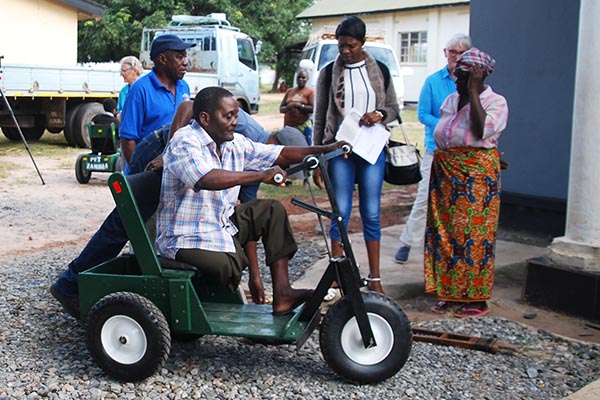About Us
PET was founded in 1995 in D.R. Congo, the location where the first PETs carts were made. However, due to all the unrest and war in that country in 2000, PET moved south to the neighboring country Zambia—and that is how PET Zambia was born.
PET Zambia has one goal in mind: To produce high-quality, low-cost carts to distribute to Africans who can’t walk. The hand-pedal powered personal transports can traverse Africa’s rugged terrain, helping those with leg disabilities maintain their dignity and regain their mobility.
The PET carts consist of steel chassis with wooden boxes bolted to them. They’re strong, light, and easy for recipients to maintain. All told, the carts cost just $100 to construct and can go up to a decade between repairs. Here’s how we keep costs low and build quality high:
What’s in a PET?
We begin by building the frames with steel from a local supplier. The steel company sells us the angle, tubing, and round bars for axles at cost because they, too, want to be part of our mission.
The lumber used in building the PET carts is also sourced locally. We like to use pine because it’s strong and light, but we were spending about a thousand dollars per month to build 50 PETs. The solution, we quickly realized, was to not purchase final-cut quality lumber at the local lumberyard. Instead, because the longest piece of lumber needed is one meter, wherever possible, we began buying their off-cuts that they normally throw away. Now, we only spend about $1000 per year on lumber.
Most of the mechanical parts — the chains, sprockets, bearings, and wheels — are shipped from the United States. The chain is not a bicycle chain; it’s a heavy-duty industrial farm chain, which can sustain years of hard use. The sprockets are made of hardened steel. The tires are made from lightweight, solid rubber to prevent blowouts.
We’re currently working with a Chinese wheel supplier to purchase and ship wheels directly from China to our headquarters in Zambia. The wheels are the most expensive parts of the PET. The wheels are currently shipped from China to the United States and then back overseas to Africa. With decreased wheel costs, we hope to build the PET carts for well under $100
Once a PET is assembled, it’s time to paint it. A paint company in Kitwe, Zambia, also wanted to be part of our mission, so they mix up a special one coat of green paint and sell it to us at cost.
After a few finishing touches and assembly, the PET is ready for distribution. We give the carts away for FREE to the disabled people in need who are able to run the machines for years without incident. Many PETs that come in for first-time repairs are around ten years old and only need new running gear and wheels. We make the replacements and get the owners back on the road in no time.
Fulfilling Our Mission
Although we’re working toward a common goal, PET Zambia functions a bit differently than our PET International affiliates in the United States. Most of the PETs built in the United States are shipped to other countries and distributed in urban or suburban areas across the developing world, while PET Zambia exclusively helps rural-Africans in Southern Central Africa; countries such as: DRCongo, Zambia, Zimbabwe, Malawi. Zambia is land-locked and surrounded by nine countries. Other countries we’re wanting to serve are: Angola, Tanzania, Mozambique, Botswana and-Namibia.
Additionally, PET International’s production costs tend to be higher, as the materials aren’t locally sourced. PET International’s carts cost well over $300 to build, while we can build carts for less than $100. However, the international organization’s carts are still an incredible value. All told, international affiliates have built more than 55,000 carts, 7,500 of which PET Zambia is responsible for.
Long Term Goals and Vision
We believe in Southern Central Africa there are millions of disabled people in the rural areas that need a cart. We did a survey many years ago in Congo. Congo is the country that gives birth to the first PETs made.
Back then, we asked our United Methodist Pastors to gather names of people in their villages that could use a PET cart. That list quickly reached over 100,000 people. This means PET Zambia would need to build 1000 PETs each month for a decade to make a dent in Congo alone. The true number for all of Southern Central Africa is unknown. Mainly, because when an African is born with a disability or has an illness or accident that leaves them disabled, these people are considered culturally cursed.
Many times these individuals are outcasts from their village and society. These people—quite often children—will be placed in the corner of the home village and be forgotten and unloved, never to be talked to or about again. It takes concerned local tribal leaders to help us find them. Also pastors, doctors, government Disabled Associations, and NGO’s to help find these special people.
With this in mind, PET Zambia is currently the only affiliate completely building carts outside of the USA. The long team vision of PET Zambia is to help build other PET affiliate workshops in Zambia’s nine neighboring countries by using PET Zambia as the model and main headquarters. The key to doing this is to build relationships with concerned individuals in each of these countries. This is essential.
If there are not real disabled people or groups or originations that work closely with the outreach of PET Zambia then we cannot build trust and accountability.
Encouragement for PET International
PET organizations rely entirely on donations. These donors want to know what their support is doing. I’m asked regularly by everyone; “Can you send more pictures and tell more stories” and I try. This close connection with PET recipients is essential. However, it’s also one essential part missing with many of our United States PET affiliates.
I personally would like to encourage each affiliate to have at least one country that they personally build PETs for. Also, just as important, they should have someone from that affiliate go to their country and build close personal contacts and relationships with their partnering country. I say it on a regular basis: Building the PET cart is the easy part, but building close relationships with the people you serve is the most important part and it takes a lot of time. It’s essential to hear their stories, seeing their communities and the places they live in. To look into their eyes and call them by name, picking them up out of the dirt and mud and putting them into their PET. This is really what it’s all about. As a pastor/ missionary, I put on hands on them and pray for them by name. I can’t encourage strong enough that each PET affiliate should have at least one country and ambassador/missionary/representative, that can go build these relationships and then come back and tell their stories. If there is anything PET Zambia can do to help with this, with regard to central Africa, we are more than willing to try to help. It’s also… just essential to building relationships with the local concerned originations, groups, or NGOs that help fine the disabled. Only then can you have true records of what is happening with your partnering investment and have accountability from them. This is the key to keeping each affiliate and their donors happy and creditable.
Another important point to keep in mind… Each country is unique and their needs are different. There is no way you can design one cart to meet all of the unique and different needs people will have. That is another wonderful reason for having a PET affiliate assembly workshop, and local representation, in the countries where they send PETs. And again, that’s why each affiliate needs to have their own personal ambassador/missionary/representative. Everyone knows America’s first rule in business… “Know your customer’s needs.” You can’t sell it, or in PET’s case – ask for donations for it, if you don’t really know personally about the recipients or the country they live in. As well as the originations, groups or NGOs in these countries that help you serve the disabled.
PET organizations rely entirely on donations, and we’ve come a long way since our genesis in 1995. Thanks to the generosity of everyday people, church groups, and foundations we’ve given the gift of mobility to tens of thousands of people around the world. With your support, we’ll continue to fulfill our mission by donating low-cost, high-quality carts to millions more.
Thank you ever so kindly….
Faithfully,
Rev. Delbert Groves
The PET unit is a hand-pedaled bike designed to mobilize people who have lost the use of there legs due to a number of reasons such as disease and war.
A PET has 4-inch wide tires which can grip rough surfaces, making it easier for users to trudge along dirt paths or rocky terrains. There are two sizes offered: a full-size adult version and a smaller one for children and small people.
PET is a labor of loved powered by the strength of our Lord, which guides us every day to help those who need it the most.
PETs Funded since 1995
To apply for qualification for a PET, please download the form by clicking on the link below.
Donate to PET Zambia
Our PET Zambia program is possible through the kind support of people just like you who see the value in helping someone find new meaning in his or her life with full mobility. You can make donations safely and securely using the PayPal button or via this link.


